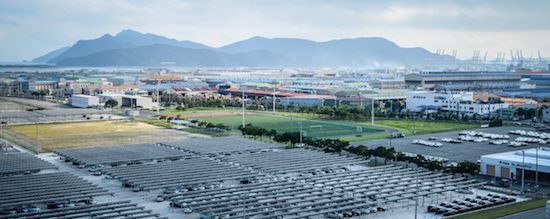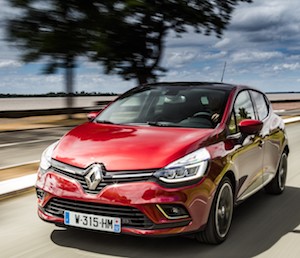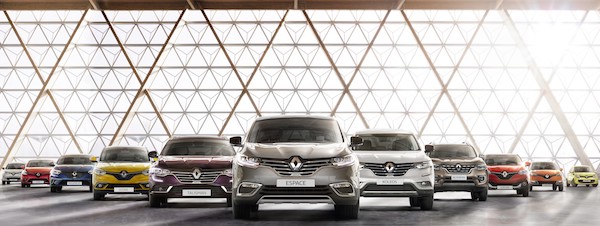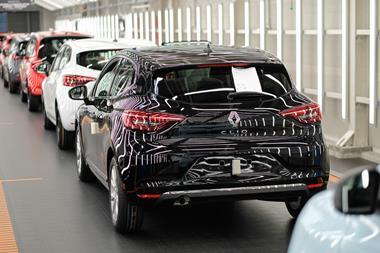Can you outline your role in Renault’s approach to sales and operations planning (S&OP)?I’m the vice-president of sales forecast and distribution. I work in sales and I run the S&OP together with my colleagues from supply chain. That already tells you something about Renault’s approach to S&OP; we manage S&OP between two units, which is supply chain, working on the upstream side, and forecasting and distribution, working on the downstream side. So that’s how the organisation stands today.
In fact, my job consists of forecasting the sales potential of our products worldwide, in all markets and all time horizons. We then run a monthly cycle in which, based on forecasts, risks and opportunities, corridor of uncertainty and so on, my colleagues from supply chain will look for the best possible production scenario.
Our objective is, on the one hand, to have as little gap as possible between our potential in terms of sales and the available production, but at the same time doing this in the most cost-efficient way. Because obviously we can over-invest in all capacities and we will be able to follow all the trends, but we will not be efficient in terms of cost. So it’s about constantly looking for optimum scenarios.

How exactly does the forecasting work and how is it changing in an increasingly digital industry?The forecasting is established by the markets, and in our monthly cycle all the markets will, under my management, show their forecasting, and they will assess risks and opportunities, which we will then consolidate. If you like, we orchestrate the bottom-up forecast.
And then our approach is that, first, my team is responsible for all the tools and methods and technologies that help our countries to forecast as well as they can. We provide metrics and the IT systems like the one we’re developing now with JDA. We are looking for new technologies which can help our countries; we need to make sure we have the best tools available.
Second, we will look at the forecasting done by the countries, and together with the operations we will have a critical approach [to] that, so we will make sure that all the opportunities are shown, we will look for perspectives which maybe the countries haven’t seen. And that’s an iterative process that we run every month where, in the end, the objective is to have the best possible view on a forecast; a centred scenario including all the risks and opportunities that we need to study.
We understood that one of our key weaknesses a couple of years ago was that we were, in fact, looking at one official scenario, knowing that, obviously, things always change and you’re never precisely right in your forecasting. But one of our basic difficulties was that we didn’t have any ‘scenario thinking’. So we would provide one forecast and then the inevitable would happen; the car market is prone to disruptions, things can happen in the market, they can slow down, they can grow faster than expected, or the performance isn’t quite what we thought it would be, it could be better or worse. And in that situation we wouldn’t be prepared. So we had no calculation on possible alternative scenarios and subsequently we couldn’t check consequences on the industrial system.
“One of our key weaknesses a couple of years ago was that we were, in fact, looking at one official scenario, knowing that, obviously, things always change… The important thing is not to be precise but to know where you are likely to be wrong and to what extent” - Florian Huettl, Groupe Renault
So we pushed this thinking in the organisation very strongly over the last couple of years and then made sure everybody accepts the fact that there are uncertainties and that you may be wrong in your forecast. The important thing is not to be precise but to know where you are likely to be wrong and to what extent.
That was a big, big change we brought into our methods a couple of years ago, which allows us to be prepared today.
Can you explain more about your work with JDA?We embarked on this journey, this project called R3, together with JDA, where we want to automate and professionalise the approach that we have, because we had changed our methods but we didn’t really work with the IT tools that supported those processes. We decided three years or so ago that we needed to get support for our methods through a [more modern] S&OP tool. That’s how we started. And this project is called ‘Right Car Right Time Right Place’ – R3 – and the JDA supply chain suite is one part of this project.
In fact we are in the middle of a complete revamp of our whole S&OP, which started a couple of years ago with introducing new methods of dynamic forecasting and scenario thinking – and that has helped a lot already in order to better deal with all the variance that we have – and we also launched the R3 project together with JDA.
[mpu_ad]What is the timeframe for the project?The project itself we started about three years ago; the part with JDA was [in 2017]. The project really is a transformation. So, when we talk about R3, we talk about changing our approach to forecasting – which we have done already – changing the IT systems to the S&OP suite with JDA, changing the governance within the regions and the countries, and exploring artificial intelligence – something that we’re paying a lot of attention to lately.
So it’s a transformation project which I don’t think will ever stop. It’s the way we approach our S&OP, but certainly at some point we’ll switch to the new system and we’ll have switched off the old one, so that will be an IT component, but the actual development of our method and the technology will certainly go on for the next couple of years.
There’s no actual start and finish to that project. There was certainly a day when we decided that we needed to make quite a radical change in what we do, but now we’re on this journey. It’s a large project, not only IT.
What would you say are the challenges involved in automotive sales forecasting at the moment?The challenges we have are not specific to the car industry. But obviously the challenges are to accept uncertainty and to capture or identify the areas where you think you’re likely to be wrong. That’s very important. And we have developed certain methods for that. We are more or less certain of our forecast, depending on the markets. So, for example, if you ask me to forecast our potential of a Clio in France, where it’s been sold for the last five generations and we have a certain position which we know, our accuracy is extremely high on that. There’s no risk in the forecasting.
If we launch a new product in India in any segment, it’s a relatively young market, our uncertainty is much higher. Or, there will be technologies that are easy to forecast because we know them – such as the take-up rate of alloy wheels, which we’ve been selling for a long time – and then there will be technologies like driving assistance or entertainment and so on, which are much more difficult to plan.
So, what we do in these cases is we establish methods that help us identify, through scoring models, the degree of uncertainty. We will score the key items of a new vehicle to find out the degree of uncertainty, and depending on [this] we’ll then look closer at these items and establish corridors that we ask our upstream to look at, to check the capacities of production and suppliers.
 It’s one challenge in our daily job to find out where we are likely to be wrong and to take appropriate measures, but we obviously have huge opportunities when it comes to big data, and that comes with the increasing capacity to digest large amounts of data, to apply machine learning technology, to work with IT systems which give us the possibility to digest all these large datasets, to build scenarios, and so on.
It’s one challenge in our daily job to find out where we are likely to be wrong and to take appropriate measures, but we obviously have huge opportunities when it comes to big data, and that comes with the increasing capacity to digest large amounts of data, to apply machine learning technology, to work with IT systems which give us the possibility to digest all these large datasets, to build scenarios, and so on.
One of our specific challenges in the car industry, and in Renault, is the complexity of our business, with multinational sourcing and a huge number of different suppliers. Variations in our forecasting and in our mix can sometimes have quite strong implications, so we need to know about those also.
For example, we know which production capacities are easy to set up and we know which capacities are difficult to set up, or which take a long time, and we’ll include this in the job we do on forecasting. We’ll take less risks on items where we know that we can get into trouble easier.
The automotive industry is introducing advanced digital technologies such as AI and ML, but do you think we’ve got the right balance between people and machines?Today, we don’t use modern IT technologies enough. In fact, my forecasting managers spend too much time doing jobs that could be automated. And they don’t have enough time to look at the actual markets, to get a deeper understanding of the market itself. So today, we clearly don’t have enough help from systems and technologies – that’s why we embarked on this journey, which also includes renewal of the IT.
“When you start introducing AI technology, there’s a question people will always ask: will the machine do my job? Will this forecasting be done automatically? That’s not at all our approach” - Florian Huettl, Groupe Renault
We started using automatic forecasts [and] artificial intelligence. We’re doing it now on markets and sales potential. It’s still early days but we are using the data and it’s part of our forecasting process. We’re covering short-term horizons, so we have started to have machine learning, predictive forecasting, on the next six months. That’s something which has become a help for our people but clearly we need more. We need to continue developing in this direction because we see that huge potential.
Beyond that, when you start introducing AI technology, obviously there’s a question that people will always ask: will the machine do my job? Will this forecasting be done automatically? That’s not at all our approach.
First, what we are working towards is an idea which is actually well in line with what JDA is doing. We are looking at some kind of autopilot approach where, in fact, we can delegate tasks of forecasting to algorithms, to our machine learning suite, and the job for AI will be to do the forecasting within limits that the forecasting managers will set. We’re trying to teach our algorithms to ‘raise a hand’ when they see that we’re running into trouble and it goes beyond their capacity. Algorithms are, after all, machines; they can’t look beyond the data that they are taught to use. They don’t go and look automatically for new data, and so on.
So we’d like to push our AI technology to the point of ‘raising hands’. The machine needs to tell its boss, the forecasting manager: ‘Everything’s okay here, here and here but I’m less sure about that one and I’m absolutely not sure what’s happening here, so please have a look’. And that’s the balance I’m looking for.
 When do you think that balance will be possible?Well, we are working on that and I know JDA is working on that also. I think it’s actually already possible in certain elements. We can already delegate certain areas of forecasting to our machine. It won’t be long. We have moved quite fast over the last couple of months. I think we’ll be able to delegate certain tasks within the next year.
When do you think that balance will be possible?Well, we are working on that and I know JDA is working on that also. I think it’s actually already possible in certain elements. We can already delegate certain areas of forecasting to our machine. It won’t be long. We have moved quite fast over the last couple of months. I think we’ll be able to delegate certain tasks within the next year.
It sounds like an exciting project.Yes, it’s very interesting. And JDA will help us in this because the forecasting suite of JDA is actually where we’re going to use our own machine learning forecasting. The step from showing it to the software manager who’s responsible, giving him additional help, and then of actually letting him use it without interfering is not a big one.
It’s not so much a question of technology. It’s more a question of governance of management. You need to decide and also to accept that certain areas you don’t do yourself any more. It’s quite a fundamental technology jump we’re doing, and you need to carry such a change in the organisation. You need to convince people, you need to show them and reassure them of the benefits. So it’s not a question of how we do it as [much as] “when can we do it”?
What do you think the automotive industry can learn from other industries in terms of technology? Would you say automotive is a leader or behind the curve?I think our industry is highly complex; worldwide manufacturing with lots of flows and connections, and so on, and I think it’s quite a challenge to be up-to-date and use the latest technologies on a large scale. It’s a considerable effort for a lot of people and it takes a lot of resources to introduce a new tool like the IBP [integrated business planning] of JDA. And that’s not something you do every year. It’s a major company project, which I think is probably a bit tougher to implement than in other industries.
I think the complexity of our industry has led to us being structurally a bit behind other industries in terms of using modern technology.
Are you working with the Alliance on this new S&OP technology?We are in close collaboration with Nissan and with partners in our field. What we are trying to do is to develop this technology for the Alliance. Nissan has been involved from the start in our AI project. The supply chain organisation is a joint Alliance function, so we are very much integrated in this area of the business. That’s how we work; if there are good technologies in certain areas of the business, we try to make it available to the Alliance.

























![Global[1]](https://d3n5uof8vony13.cloudfront.net/Pictures/web/a/d/s/global1_726550.svgz)










